Three groups of linguistic varieties are studied in our project: Singpho, Tai and Tangsa.
SINGPHO:
Singpho is part of the Bodo-Konyak-Jinghpaw group within Tibeto-Burman (Burling 2003:176). It is closely related to but not the same as Jinghpaw as spoken in Burma (Hanson 1896, 1906, Maran 1971, Matisoff 1974a, 1974b) and in China (Dai 1992, Dai and Diehl 2003). Unlike the Jinghpaws of Burma and China, the Singphos of India are a small population, and also unlike the Jinghpaws, they have not converted to Christianity. Though most Singphos today are Buddhists, some of their ancient beliefs, such as placating nats or ancestor spirits, are still practised and still known.
The Singpho of Upper Assam and Arunachal Pradesh are divided into four groups, locally known as Numhpuk Hkawng, Diyun Hkawng, Tieng Hkawng and Turung Hkawng. Hkawng is a term meaning ‘area’ and each of these groups is named after a local river. Numhpuk is a Singpho term incorporating the word for a woman, num.
The Turung are also known as the Tai Turung, and some of the older Turung people say that their ancestors were Tai speakers (speaking Tairong).
Example of Turung language, from Nemi Mang, told by Bong Jap: (Turung has three tones 1: low, 2: high falling, 3: level)
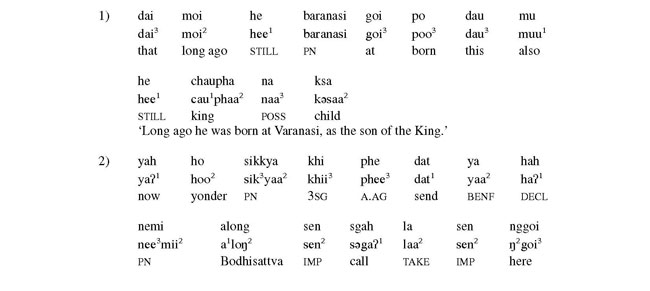

Example of Numhpuk Singpho, a traditional Săyaw Goi song, sung by Gădung Lu Bisa Jan: (Numhpuk Singpho is analysed as having five tones 1: low, 2: low stopped, 3: high stopped, 4:level, 5: high falling)

TAI:
Tai Language is traditionally conceived of as having 6 groups in Assam: Tai Aiton, Tai Phake, Tai Khamyang, Tai Khamti, all of whom still speak Tai, as well as Tai Turung (now all speaking a variety of Singpho) and Tai Ahom (now all speaking Assamese). Tai Ahom is now only used in ritual, but remains in many thousands of manuscripts, such as this from the Ma Likha Lit:

The translation of Ahom texts has been possible in combination with the expertise of Chaichuen Khamdaengyodtai, together with Tai speakers such as the Aiton scholar, Nabin Shyam Phalung. Although the traditional Ahom priests no longer speak Tai Ahom as a mother tongue, they retain a considerable amount of traditional knowledge and thus a large group of people is needed for good translation of these texts. Example of Ahom Text (from the Ma Likha Lit MS, first two lines) (Nothing is known about the tones of Ahom)
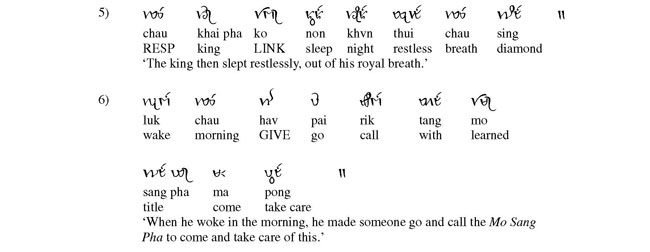
Of the spoken Tai languages, Aiton, Phake and Khamti are still being learned by children, but Khamyang is only known by a few elderly people in a single village. Traditional songs are now sung by very few people.
Example from a Rice Pounding song, sung by the late Ngi Pe Pang (recorded by Dr. Banchob Bandhumedha in the 1960s). This example employs the Tai Phake script and the phonemic transcription devised by Dr. Banchob. (Tai Phake has six tones: 1: level, 2: high falling, 3: creaky, 4: falling, 5: low falling; 6: rising)

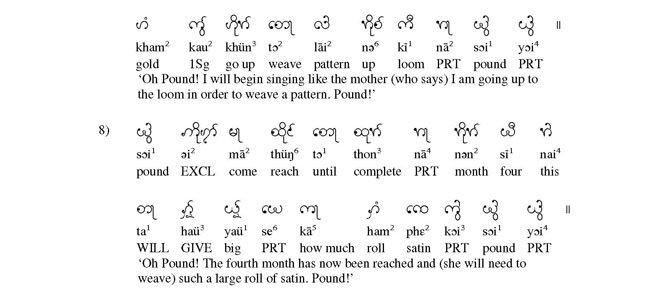
TANGSA:
The languages spoken by the Tangsa belong to the Konyak group within the Bodo-Konyak-Jinghpaw group within Tibeto-Burman (Burling 2003:176). In the Ethnologue they are referred to as Naga, Tase. There is considerable linguistic variety within the Tangsa groups. Consider the following Table which compares words in Cholim and Lochhang, two Tangsa varieties:

The tones of the two varieties are as follows:

The Cholim call themselves [ʨo¹lim³], literally ‘yam hot’, whereas the Lochhangs call them [tjaŋ²lam³] which means ‘yam boiled’ in Lochhang. The ‘general name’ used by other Tangsas, and by Cholims with outsiders, is Tonglum. Thus our main consultant in the Cholim area is called Lukam Tonglum (or Tonglim) in general parlance, but his Cholim name is Loekyam Cholim.
Here is an example from a story told by Lukam, a story of the Nagas: (Tangsa tones are 1:high level, glottalised, 2: low falling, 3: high falling)
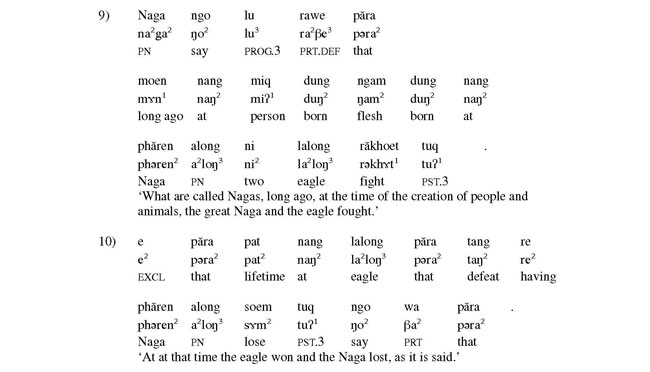
Many traditional songs are still sung by the various Tangsa groups. Here is the text of a Cholim dance-song, sung by a group of young women led by Chonja Tonglum.

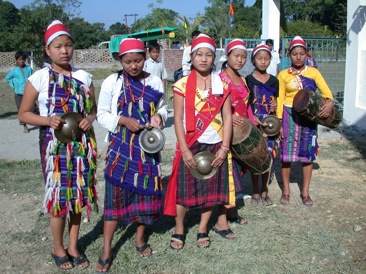
Cholim dance troupe
The Hakhun are included under Tangsa for political purposes, but their language is much closer to Nocte (also within the Konyak group). The Hakhun tones are presented in Table 2.

Other examples of these tones are as follows:

The stop final tone distinction is illustrated in Table 4

Hakhun has a complex system of agreement marking. Verbs are marked for person that agrees with the subject, and agrees with both subject and object where the object is 1st or 2nd person. The system for agreement when there is a 2nd person subject and 1st person object is given in Table 5:

As we can see, the endings agree with the 1st person when the subject is 2nd person singular, but there are special forms in final -a¹ when the subject is 2nd person plural and the object is 1st person singular. Consider the following examples:
- You are hitting me Noe keamea nga bu-roe¹
- You are hitting us Noe keamea noerum bu-ri¹
- You (pl) are hitting us Nuqrum keamea nirum bu-ri¹
- You (pl) are hitting me Nuqrum keamea nga bu-ra¹
In (38), we see the first person agreement ending -oe¹ with the r- that we have already mentioned above. This r- is a hierarchical marker, because in the Hakhun grammar, 1st person is usually the subject and other persons the object. Since this situation is reversed in (38), where the 2nd person is subject and 1st person is object, r- is placed. Agreement with the object also applies in (39) and (40) where the 1st person plural marker is -i¹. There is however a special form for the 2nd person plural subject and 1st person singular object, and this is -a¹, as shown in (41).


